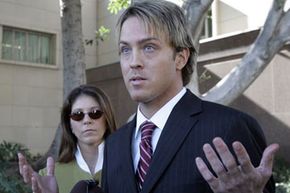Advances in DNA Evidence
In 1985, DNA entered the courtroom for the first time as evidence in a trial, but it wasn't until 1988 that DNA evidence actually sent someone to jail. This is a complex area of forensic science that relies heavily on statistical predictions. In early cases where jurors were hit with reams of evidence heavily laden with mathematical formulas, it was easy for defense attorneys to create doubt in jurors' minds. Since then, a number of advances have allowed criminal investigators to perfect the techniques involved and face down legal challenges to DNA fingerprinting. Improvements include:
- New testing procedures -- RFLP analysis required large amounts of relatively high-quality DNA. Newer procedures require far less DNA and can be completed faster.
- Source of DNA -- Science has devised ingenious ways of extracting DNA from sources that used to be too difficult or too contaminated to use. And in some cases, detectives are using DNA analysis in ingenious ways to get a conviction. For example, detectives in Phoenix, Ariz., were able to link a suspect to a murder victim by testing the DNA of a palo verde tree found at the crime scene. Palo verde trees feature pods containing seeds. Some of these pods were found in the suspect's truck. To prove that the pods came from the tree found at the crime scene and not some other palo verde tree, detectives turned to DNA analysis. The pods found in the truck matched each other -- and matched the pods taken from the tree at the crime scene. It was the first time the DNA fingerprint of a plant was used in a criminal trial.
- Expanded DNA databases -- The databases managed by the CODIS software continue to expand. Prior to 2006, only convicted felons were required to have their DNA profiles entered into the database. But a January 2006 law, which was signed by President Bush and funded in 2008, has expanded collection of DNA samples beyond convicts to include federal arrestees, as well as suspected illegal immigrants or captives in the war on terrorism. Justice officials estimate the new collecting requirements will add DNA from an additional 1.2 million people to the database each year [source: UPI].
- Training -- Crime labs have developed formal protocols for handling and processing evidence, reducing the likelihood of contamination of samples. On the courtroom side, prosecutors have become savvier at presenting genetic evidence, and many states have come up with specific rules governing its admissibility in court cases. See How CSI Works for more details.
The advances that have made DNA evidence an invaluable tool in the criminal justice system have also galvanized public interest. Classroom study of DNA and its properties has become more in-depth and widespread in many schools. And television crime dramas that feature DNA evidence so prominently continue to flourish. All of that awareness brings good news and bad news, but the real bad news is reserved for criminals, who will find it increasingly difficult to leave a crime scene without leaving a piece of incriminating biological evidence behind.
Advertisement
Related HowStuffWorks Articles
Sources
- Colimore, Edward. "Museum puts off DNA testing of Lincoln artifact for now." The Philadelphia Enquirer. May 5, 2009 (Aug. 20, 2009)http://www.philly.com/inquirer/front_page/20090505_Museum_puts_off_DNA_testing_of_Lincoln_artifact_for_now.html
- Environmental News Network. "DNA technology busts wildlife poachers." CNN.com. May 29, 2000. (Aug. 20, 2009)http://archives.cnn.com/2000/NATURE/05/29/dna.poaching.enn/index.html
- FBI, Criminal Justice Information Services. "Combined DNA Index System." (Oct. 28, 2020) https://www.fbi.gov/services/laboratory/biometric-analysis/codis
- Fink, Sheri. "Reasonable Doubt." Discover Magazine. July 29, 2006. (Aug. 20, 2009)http://discovermagazine.com/2006/jul/reasonable-doubt
- Houck, Max M. "CSI: Reality." Scientific American. July 2006.
- National Institute of Justice. "The Future of Forensic DNA Testing." November 2000.www.ncjrs.gov/pdffiles1/nij/183697.pdf
- National Institute of Justice. "Using DNA to Solve Cold Cases." July 2002.www.ncjrs.gov/pdffiles1/nij/194197.pdf
- Pollack, Andrew. "DNA Evidence Can Be Fabricated, Scientists Show." New York
- Times. Aug. 17, 2009. (Aug. 20, 2009)http://www.nytimes.com/2009/08/18/science/18dna.html?_r=4
- United Press International. "Plan for DNA database moves forward." April 19, 2008. (Aug. 20, 2009)http://www.upi.com/Top_News/2008/04/19/Plan-for-DNA-database-moves-forward/UPI-62151208628916/
